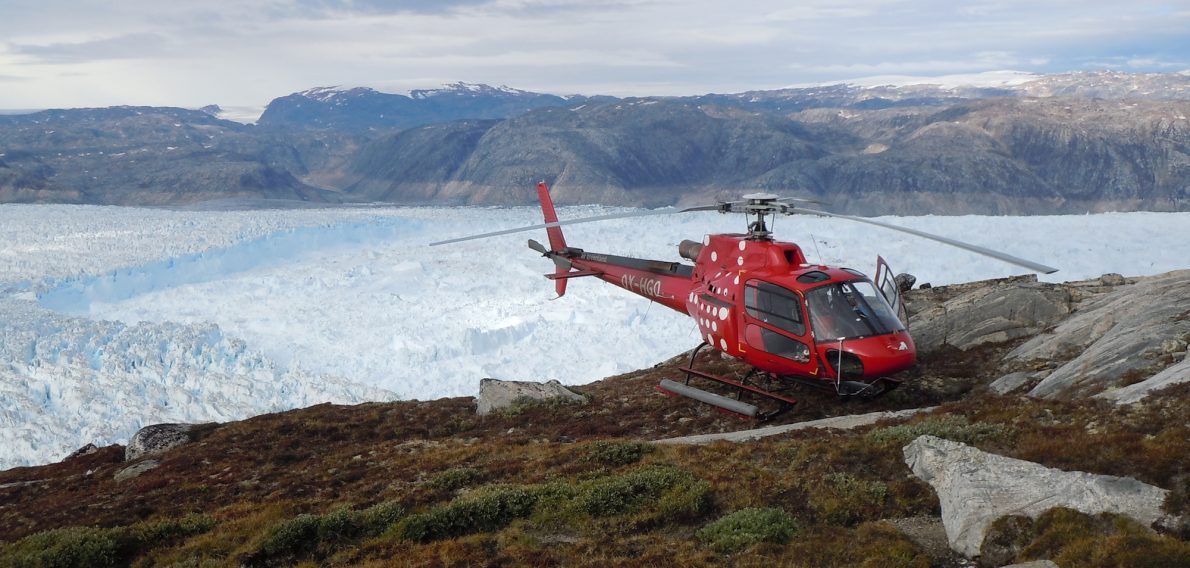The wild blaring of the alarm suggested we were either going to hit something or the helicopter was about to break apart. I could see the dark water of the fjord rotating through the roof window of the little red-and-white spotted Air Greenland helo. Water through the roof window… is it possible these things can fly upside down? I didn’t think so, but it was hard to tell which direction was up anyway. We were corkscrewing down so rapidly the centripetal force pulled at my cheeks and eyelids, molding a frown which was a pale reflection of the anxiety I was feeling inside. The meaning of the alarm was as intuitively obvious as the dry rattle of a poisonous snake – a danger sign instantly recognizable even if you’ve never heard it before. It was the exact sound that, in action movies, indicates the fighter jet “ground proximity” or “stall” warning. Hearing it immediately conjures images of grimacing pilots pulling back on control yolks.
Just when the spinning water and ice of the fjord seemed close enough to touch though that roof window, the pilot righted the helicopter and slammed to a stop on a cushion of air. We calmly floated a dozen meters or so above the surface, surrounded by a crystalline city of ice towers. The alarm quieted, replaced by the regular thwap-thwap of the rotor blades.
Instead of the expected gentle descent to the open water, Tom deftly executed this airshow-esq display of helicopter aerodynamics, demonstrating capabilities of which I had been previously, blissfully, unaware. Though Tom obviously knew his machine and its abilities perfectly, he got a kick out of surprising the uninitiated oceanographers sitting in back.
After our stomaches settled, Magdalena opened the helicopter door part way to allow me to drop the XCTD. Checking my harness for the 15th time, I reached out over the open water of the lead, positioning the instrument for deployment as Magdalena held the door firmly against my shoulder. One of the dozen or so ways Tom (jokingly?) informed us it was possible to die on this trip would be to let the door open fully, extending it into the rotor blades, causing what one could only assume to be a precipitous loss of lift.
[vimeo 88995787 w=500 h=281]
Pulling the pin on the launcher, I watched as the little torpedo-shaped temperature probe plunged into the freezing water. At the surface those waters are truly frigid, but, counterintuitively, the temperature increased the deeper the probe fell. Attached by more than a kilometer of hair-thin copper wire to a computer in the helicopter, the probe sent back temperature and salinity measurements as it dove. Fiamma reported the temperature readings as they appeared on the computer screen: “surface: -1.6 degree celsius … 50 meters: -0.5 degrees … 100 m: 1.7 degrees … 200 meters: 2.8 degrees …” and on. We hovered over the open water as the probe fell deeper and deeper. By the time it hit bottom at 650 meters, the temperature had increased to 4 degrees, nearly 6 degrees above the melting point at the base of the glacier. Underneath all that frozen slush was a thick layer of ‘warm’ water pressing right up against Helheim. This warm, deep, water flows into the fjord from the Atlantic and is part of the reason why I was hanging out of a helicopter a few miles south of the Arctic circle.

In general, we know very little about how the relatively warm ocean and the huge mass of ice atop Greenland interact. From observations like those we made from the helicopter, we know warm ocean waters reach the 600m vertical wall of ice at the end of Helheim glacier carrying enough heat to do a significant amount of melting. How might the delivery of that heat affect the stability of the glacier? Could changes recently observed in the ocean offshore cause changes in the rate of ice melt on Greenland? How does the freshwater produced when the glacier melts into the sea affect ocean circulation? These are some of the big questions our group and others are trying to answer.
Though they might not seem obviously so, these are important and directly relevant questions for all of us. The huge ice sheet of Greenland is melting at four times the rate it was in the 1990s, currently contributing twice as much to observed global sea level as melting glaciers in Antarctica [Straneo & Heimbach]. There are indications that it is draining freshwater into the North Atlantic ocean in quantities nearly large enough to disrupt large scale ocean circulation [Bamber et al.]. Making observations near the interface between ocean and ice helps move us towards our ultimate goal of understanding and possibly predicting future changes in the ice sheet. Predicting the future of the ice sheet alone doesn’t give us any control over what happens down the road. But just as with a weather forecast, the prediction helps us intelligently prepare for the future.
We deployed seven XCTDs in the melange that afternoon, obtaining some valuable data to add to the extremely scarce measurements of ocean properties near tidewater glaciers. Hovering over the leads, we were a bit like fish out of water, oceanographers leaving our boats and taking to the air. But the ride was exciting and the observations are invaluable; and at each station Magdalena held the helicopter door. Tight.





